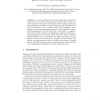414 search results - page 41 / 83 » Functional Programming in Sublinear Space |
BMCBI
2004
13 years 9 months ago
2004
Background: All known genomes code for a large number of transcription factors. It is important to develop methods that will reveal how these transcription factors act on a genome...
CEC
2011
IEEE
12 years 10 months ago
2011
IEEE
—Constrained Genetic Programming (CGP) is a method of searching the Genetic Programming search space non-uniformly, giving preferences to certain subspaces according to some heur...
CORR
2006
Springer
13 years 10 months ago
2006
Springer
In a previous paper [16], the sup-interpretation method was proposed as a new tool to control memory resources of first order functional programs with pattern matching by static an...
POPL
2006
ACM
14 years 10 months ago
2006
ACM
Functional programmers often reason about programs as if they were written in a total language, expecting the results to carry over to non-total (partial) languages. We justify su...
NIPS
1993
13 years 11 months ago
1993
This paper introduces GNARL, an evolutionary program which induces recurrent neural networks that are structurally unconstrained. In contrast to constructive and destructive algor...

